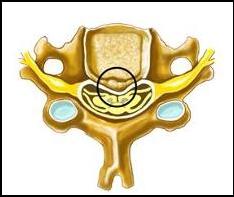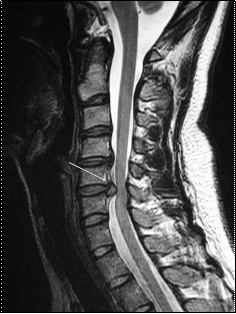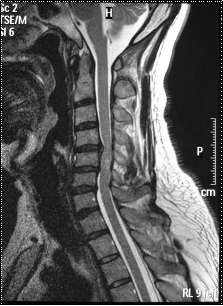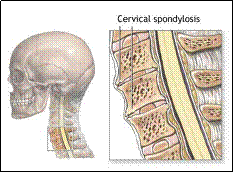
|
Acute Cervical Disc Prolapse Cervical Spondylotic Myelopathy |
|
· FEATURES: · In older patients as a result of osteophytic spurs impinging onto spinal cord · In younger patients frequently as a result of herniated nucleus pulposus · The end result may be similar with a neurological compression syndrome - cervical myelopathy |
|
Natural wear and tear or ageing of the spine is otherwise known as cervical spondylosis. The process begins with disc degeneration or ageing, the intervertebral discs start to lose water content and increase their collagen content becoming more and more dessicated. The intervertebral disc loses pressure, it becomes not unlike a flattened car tyre, with bulging walls. Increased shear stresses across the bony endplates of the bone above and below the disc produce bony remodeling and the formation of osteophytes. In the presence of a congenitally narrow spinal canal these osteophytic spurs and associated posterior ligamentum flavum infolding are the main culprits in the development of neural impingement and cervical spinal cord compression. Smokers are much more likely to develop disc degeneration. |
|
CERVICAL SPONDYLOSIS |


|
HARD DISC HERNIATION OSTEOPHYTE and DISC |
|
SOFT (NUCLEUS) HERNIATION |

|
In the younger population the intervertebral disc is well hydrated, damage to the annular fibrosis and annular fibers of the disc can result in a sudden herniation of disc material into the spinal canal causing an acute disc herniation otherwise known as herniated nucleus pulposus. |
|
ACUTE CERVICAL DISC PROLAPSE |


|
4th Decade |
|
2nd Decade |

|
Copyright © 2008 Spine Care Hong Kong |

|
INTERVERTEBRAL DISC AGEING |
|
MILD SPONDYLOTIC MYELOPATHY |
|
SEVERE SPONDYLOTIC MYELOPATHY |



|
SPINE CARE HONG KONG |
|
ACCURATE DIAGNOSIS, STRUCTURED TREATMENT |
